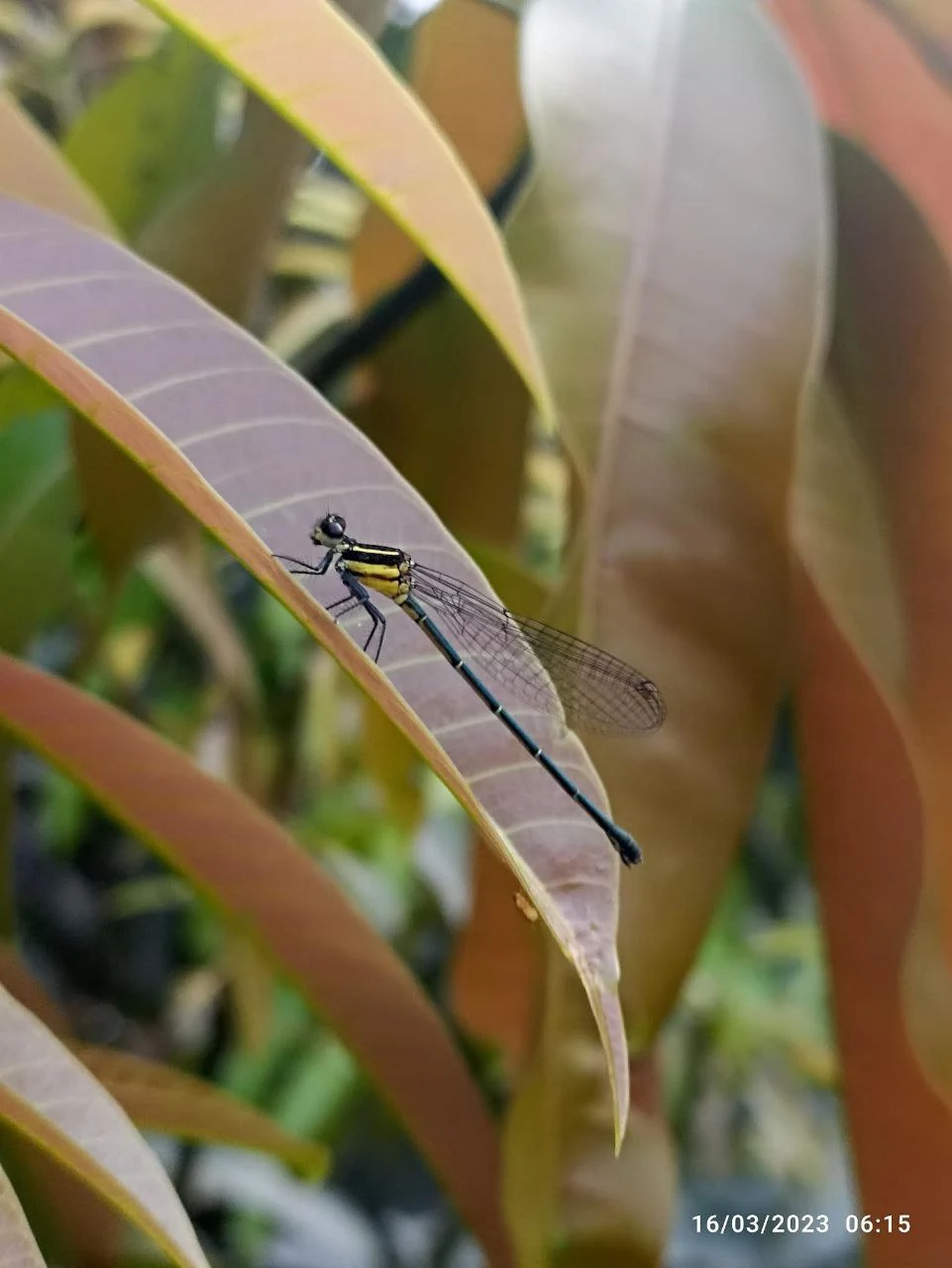Copera vittata
Domain: Eukaryota
Kingdom: Animalia
Phylum: Arthropoda
Class: Insecta
Order: Odonata
Suborder: Zygoptera
Family: Platycnemididae
Genus: Copera
Species: C. vittata
- It is also known as the blue bush dart.
- Commonly found near the river banks or at dark places.
- The male is easily differentiated due to their red color legs.
- They mainly live in dark and moist areas.
- Widely distributed in Asia.
- Thorax is black.
- There are 6 legs.
- Two big compound eyes.
- Big transparent wings.
- Yellow, black, and reddish in color.
- Black strips on the thorax.
- Conical-shaped head.
- There are 10 segments in the abdominal region.
This damselfly exhibits medium size, featuring brown-capped yellow eyes accented by a slender black band encircling the equatorial region. The thorax displays a black dorsum with a distinctive narrow humeral stripe in bluish-yellow, split into two sections that overlap. Following this stripe is a broad black fascia situated on the thorax's lateral side, adorned with small pale yellow spots. Beyond this, the lateral sides turn yellow, featuring an irregular black stripe along the anterior border of the postero-lateral suture and another on the middle part of the metepimeron. The abdomen is primarily black on the dorsal half up to segment 8, transitioning to a paler shade on the ventral half with a bluish-white basal annulus. Segment 9 showcases a black basal half and a bluish-white apical half, while Segment 10 is entirely bluish-white.
The anal appendages are either pale blue or creamy white, with the superiors matching the length of segment 10, conical in shape, and tapering at the tips. The inferiors are nearly twice as long as the superiors, exhibiting a pale internal color and a blackish-brown external hue. In comparison to the related species Copera marginipes, where the superiors are half the length of segment 10 and the inferiors are at least four times the length of superiors, the described damselfly presents distinct characteristics. Additionally, the inferiors in this species are tipped with black underneath.
HERE WE HAVE MAJOR INFORMATION
Certainly! Let's delve into the world of Copera vittata, commonly known as the white-striped black moth.
Copera vittata is a fascinating insect species that belongs to the family Erebidae, which includes a wide array of moths. What sets this particular species apart is its striking appearance characterized by black wings adorned with prominent white stripes. These stripes not only serve as a distinguishing feature but also play a crucial role in the moth's survival in its natural habitat.
These moths are primarily found in various regions across the globe, particularly in temperate and tropical climates where they thrive in diverse ecosystems. From lush forests to urban areas, Copera vittata demonstrates adaptability to different environments, showcasing its resilience as a species.
One of the most intriguing aspects of Copera vittata is its life cycle, which follows the typical stages of metamorphosis seen in many moth species. It begins as an egg laid by the female moth on suitable host plants. Upon hatching, the larva emerges, embarking on its journey of growth and development. During this stage, the caterpillar feeds voraciously on plant foliage, utilizing its specialized mouthparts to consume nutrients essential for its maturation.
As the larva matures, it undergoes several molts, shedding its outer skin to accommodate its increasing size. This process continues until the caterpillar reaches its final instar, signaling the onset of pupation. The pupa, or chrysalis, serves as a protective cocoon where the caterpillar undergoes a remarkable transformation, eventually emerging as an adult moth.
Once emerged, the adult Copera vittata seeks out mates to continue the cycle of reproduction. Utilizing various methods such as pheromones and visual cues, these moths engage in courtship rituals, ultimately leading to mating. After fertilization, the female moth lays eggs on suitable host plants, thereby completing the life cycle.
In addition to their intriguing biology, Copera vittata plays a significant ecological role within their respective habitats. As herbivores, the larvae contribute to the natural balance by consuming plant matter, which helps regulate vegetation growth and nutrient cycling. Furthermore, adult moths serve as pollinators, aiding in the reproduction of flowering plants and contributing to ecosystem diversity.
However, like many other insect species, Copera vittata faces various threats to its existence. Habitat loss, pesticide use, and climate change are among the factors that pose challenges to their survival. Conservation efforts aimed at preserving natural habitats, reducing pesticide usage, and raising awareness about the importance of biodiversity are crucial in safeguarding the future of Copera vittata and other vulnerable species.
In conclusion, Copera vittata, with its distinctive appearance and fascinating life cycle, serves as a testament to the wonders of the natural world. By understanding and appreciating these creatures, we not only gain insights into their intricate biology but also recognize the interconnectedness of all living organisms within the ecosystem. Through conservation and stewardship, we can ensure that species like Copera vittata continue to thrive for generations to come.


No comments:
Post a Comment